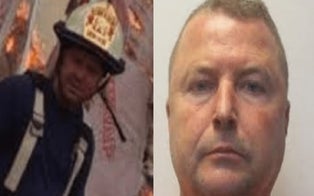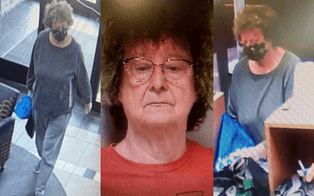Joe Petrosino worked his way up the ranks of the NYPD to become the first Italian detective. He led a special task force called the Italian Squad, which was hellbent on taking down the secret society known as the Black Hand as well as the Mafia.
Towards the end of the 19th century and the turn of the 20th, one New York immigrant community was terrorized by their own people.
Italian immigrants arriving in America in search of a better life were treated as subhuman. On top of that, a secret society known as the Black Hand, which was a loose organization of Italian criminals, terrorized the new arrivals with kidnappings, murder and extortion. The fear amongst the Italian community went on for years until one man stood up for not just the scared citizens of New York City but for his people around the country.
Joe Petrosino was an immigrant who believed in the American dream and worked his way up the ranks of the NYPD to become the first Italian detective. He led a special task force called the Italian Squad, which was hellbent on taking down the Black Hand as well as the Mafia.
In March 1909 while on a secret mission in Palermo, Sicily, he was murdered.
Over 100 years later, his death remains unsolved.
His brave detective work and how he transformed the NYPD shows that his legacy still looms large.
They’re Coming to America
The 1800s saw change in America as scores of immigrants arrived from Europe, including the Irish, Germans and eventually Italians, as the young nation struggled to keep itself together amidst the Civil War, the end of slavery, the assassination of a president and Reconstruction.
In the late 1800s, Italian immigrants arrived on America's shores in droves, with many of them ending up in major cities like Boston, New Orleans, Philadelphia and New York City.
However, being an Italian immigrant in America at that time wasn’t ideal.
Paul Moses, historian and author of “The Italian Squad,” tells Inside Edition Digital, “The Irish came, but they mostly spoke English. No doubt they had their own issues to overcome. And a large German migration were light-skinned Northern European people. The Italians came and they just seemed so different. What's this food they eat? This tomato pie and exotic things like ravioli and lasagna and the vegetables they sell in the market? So they were just very, very different. So there was really a lot of bias against the Italian immigrants.”
Italian immigrants faced lynching in the South, primarily in Louisiana, as the city of New Orleans at the time was home to more Italian immigrants than any other southern state, according to the History Channel. Between 1884 and 1924, nearly 300,000 Italian immigrants, most of them Sicilian, moved to New Orleans, earning the French Quarter the nickname “Little Palermo,” according to the History Channel.
New Orleans saw one of the largest mass lynchings in American history, when 11 Italian men were hanged in 1891 after a cop was killed. Citizens believed it was done by Italians using so-called mob justice, as they killed the men without any evidence of their guilt, according to the History Channel.
Among the huddled masses seeking a better life in a new land was Joseph Petrosino, who arrived in America as a little boy from Padula, Italy, to live with his grandfather and cousin.
Petrosino’s time in New York City was marked by tragedy from early on as his grandfather was struck and killed by a streetcar, forcing the young boy and his cousin to live in an orphanage until arraignments could be made for relatives in Italy to come and care for the children. However, the judge presiding over Petrosino’s case reportedly took pity on him and took the child and his cousin in to live with his family until relatives from Italy arrived, according to “The Black Hand,” by Stephen Talty.
Much of the Petrosino clan eventually arrived in New York City and Joseph and his cousin were soon back in their family’s care. While living in tenements in Manhattan, young Joseph became a shoe shiner outside police headquarters.
While shining shoes in front of NYPD headquarters, Joseph got offered a job with the NYC Department of Sanitation, which in those days was run by the NYPD. Petrosino would soon go from cleaning the streets to cleaning up the streets, according to Moses.
“He got a job working on garbage scows, which at that time were part of the street cleaning department, which was part of the police department [and] caught the eye of a famous inspector who recognized that they needed some police who could speak Italian and brought him into the department even though he was under the size cops were supposed to be at that time and he was a brilliant detective, a national celebrity in his day,” Moses tells Inside Edition Digital.
Because he was fluent in many Italian dialects, Petrosino aided the police by working undercover as an informer, Moses says. He officially joined the police department in 1883, and in 1895, then-Police Commissioner Theodore Roosevelt personally promoted Petrosino to Sergeant of Detectives.
While things were going well for Petrosino at the time, it wasn’t the case for everyone in New York City.
Geoff Schumacher, vice president of Exhibitions and Programs at the Mob Museum, tells Inside Edition Digital that Italian immigrants coming through Ellis Island and into New York City were looked at as the bottom of the barrel.
“They were given the worst jobs. They had the worst housing. They lived in tenement housing, very compact, many, many people to a room kind of a situation,” he says. “They were discriminated against, clearly, and when it came to the police department, the police department was almost entirely Irish, most of them, very, very few of them, spoke Italian. So they could not communicate with the Italians at all. And they really just kind of let whatever was happening in Little Italy, in Lower East Side of New York or Manhattan, they were just like, ‘You guys, figure it out, because we can't talk to you, we can't help you, and we don't really want to.’”
The Black Hand
In the late 1800s and early 1900s, Italian immigrants who were making a decent wage or finding ways to set up their own stores started getting threatening letters in the mail. Some of these letters were written in Italian, some in English, but all threatened to kidnap the recipients’ children or blow up their business if they didn’t hand over a large sum of money. All the letters were signed with the same insignia which would later be known as the "Black Hand.”
“The Black Hand was basically an extortion racket. It was individuals or small groups of men, who were of Italian descent, many of them immigrants from Italy, from Sicily and Southern Italy. And they came to the United States. They came to New York and other cities, and they engaged in the sort of back and forth with individuals, in which they were trying to make money or trying to get money,” Schumacher says. “This was very fearful. People were afraid. Or a businessman might be defiant and ignore the letter, in which case he ran the risk of the business being burned down. And this happened. These guys would actually act on it. It was not a bluff.”
While many were afraid to go to the police with the matter, some Italians went to Petrosino with the letters. Petrosino would help as best he could but knew he could not do it alone.
“I think it's very typical of immigrant groups in general, to have one group of criminals who prey on their own people,” Moses says. “That's not unique to Italians at all. I think with Italians, it maybe got a little out of hand because it wasn't very well policed, and the Italians were not interested in cooperating with the police very much either.”
As children of Italian immigrants began getting kidnapped in broad daylight and women started getting attacked at night, the NYPD and the press could no longer ignore what was happening. It reached fever pitch when famed Italian tenor Enrico Caruso and his family became the target of the Black Hand.
The news of Caruso’s shakedown by the Black Hand made national and international headlines. Because of Caruso’s celebrity, pressure was put on the NYPD to help crack who was behind these letters.
“The Black Hand was not a giant conspiracy of criminals organized from either Sicily or Naples, as was commonly supposed at the time. Black Hand was a kind of umbrella term for individual and usually separate groups of thugs who seized on a very frightening logo, a black hand, put it on blackmail letters in order to extort money from Italian immigrants who achieved some degree of success,” Moses says. “The Black Hand was really a logo more than an organization. And the detectives in the Italian Squad tried to make that point many times, but never really got anywhere because the story of a giant conspiracy run by the Mafia in Italy was just too good to resist at the time.”
Thanks to Petrosino’s ability to connect with his community, speak multiple Italian dialects and blend in, he was ordered to lead one of the first task forces in NYPD history known as the "Italian Squad.”
“In 1904, in response to a pretty bad round of bombings and kidnappings, the police department started a unit, a small unit of Italian-speaking detectives under Joseph Petrosino. That was the official name was the Italian Squad, sometimes called the Italian Bureau of the Police Department,” Moses says. “They had a number of officers in precincts, detectives in precincts that had large Italian populations who were supposed to cooperate with it. So that became the nucleus of this Italian squad, and it was designed to crack down on crime in the Italian community, and I think served a particular role in being a bridge to a community that was very isolated from the police department.”
As investigations were inconclusive, the press at the time believed that because the letters were written in Italian, the Black Hand had to be a Mafia secret society. However, years of research have proven this theory wrong.
“There were Mafia groups in New York and elsewhere at this time,” Schumacher says. “The Black Hand was most prominent in the U.S. from 1900 to 1920, and there were people who were in the Mafia, who were engaging in Black Hand activities. There were people engaging in Black Hand activities, who had associations with the Mafia, but they're not the same thing. They are separate things.”
Petrosino would use disguises like fake mustaches and blue-collar clothing in order to blend in to help solve some of the crimes of the Black Hand. Petrosino and his men in the Italian Squad would become the nation’s first undercover detectives, earning their leader the nickname, "The Italian Sherlock Holmes.”
Petrosino and the Italian Squad worked in their own office in Little Italy, not too far from police headquarters. To avoid being identified going in and out of their nondescript office, the detectives of the Italian Squad would often wear women’s clothes or dress in other disguises whenever they were dealing with the public. This gave way to basic investigative procedures authorities around the world use today.
“Undercover work was an innovation. Informants was an innovation. And then, one of the things that was happening, of course, is, when people weren't paying these extortion demands, then their buildings got blown up,” Schumacher says.
Schumacher also says that it “was Petrosino who created the bomb squad for NYPD, the first ever bomb squad in America. And today, it's still operating, obviously. And so, he was really involved, he and his team were involved in learning about the techniques of and how to investigate bombings.”
The more the Italian Squad was able to do, the more the NYPD put them in the public spotlight, especially Petrosino, who used the press to show the strength of the NYPD and how they would not be intimidated by the Black Hand.
“As Petrosino's name appeared in the newspaper more and more, he became a target. He was putting himself and his work in a difficult position. It would not be surprising if someone wanted to retaliate against him,” Schumacher says. “As things evolved with the Italian Squad, they were making a lot of progress in taking down Black Handers. But this was happening at the same time as the city was growing with more and more Italian immigrants than other immigrants and the crime was increasing. It was sort of like taking one step forward and two steps back.”
In 1909, Petrosino and the NYPD’s top brass concocted an ingenious idea for the cunning detective to go overseas and gather intel on Italian criminals in order to prevent them from entering America.
“A study was done that showed that one of the problems they were dealing with was they could not figure out how to prevent these criminals immigrating from Italy and coming to the U.S., and what they had found was almost all the Black Handers that they had arrested or that they had convicted had criminal records back in Italy,” Schumacher says. “If you could know that these guys had criminal records when they stepped up to Ellis Island or whatever, then you could send them home, you could prevent them from coming in.”
In the Palm of The Black Hand
Petrosino’s plan to go to Italy and Sicily was supposed to be classified. Only top NYPD members and the Italian Squad were to know about his travels abroad. However, word leaked out to the press and newspapers ran with the story that the fearless crime fighter was overseas.
As word got out that the world’s most-famous living detective was in Sicily, members of Palermo’s infamous underworld got some ideas.
“He had been warned before he went, by multiple people, that this was a very dangerous mission, that he was known worldwide, and certainly, he was known in Italian circles, Italian criminal circles. And so, this was very dangerous for him to go to Italy and operate this way. And he decided to go by himself, which is odd as well,” Schumacher says.
After having dinner in Palermo on March 9, 1909, Petrosino went for a walk and was approached by two men, according to reports. One of them pulled a gun and shot and killed the detective. The two assailants fled the scene and were never found.
Word got to America that the world’s most famous detective had been murdered.
“It's somewhat surprising that it didn't happen in the United States, it did not happen in New York, and that might be in part because of the fear of exactly what the result would be if they, let's say the Mafia or the Black Hand, had hurt or killed Petrosino, at that time. I can imagine the wrath of the police department would've been unbelievable, and so nobody really wanted to go there, because of the ramifications,” Schumacher says.
Joseph Petrosino was 48 years old when he was killed. He was survived by his wife and infant child.
Petrosino’s funeral was flooded with a sea of humanity as 200,000 people tried to pack into St. Patrick's Cathedral. All of them later walked in a procession from Manhattan to his grave at Calvary Cemetery in Queens.
His death is the only murder in NYPD history to have occurred overseas. Despite his high-profile murder, it has never been solved.
“Although we don't know for certain who pulled the trigger and who was behind it, over the past hundred years, people have done a lot of work on this, and we have a pretty good idea that it was, in fact, individuals who knew very well who Petrosino was and wanted to stop him, because he had been a very effective opponent of the Black Hand and the Mafia,” Schumacher says.
Both Italian authorities and NYPD arrested people believed to have been behind the assassination, but they were never convicted. Some criminals, like infamous gangsters Giuseppe Morello and Ignazio Lupo of the Morello crime family, boasted about killing Petrosino, but there is no evidence to suggest that.
“Morello would not have been the trigger man or Lupo. They stayed in New York, but they were working with a genuine Mafia don, Vito Cascio Ferro, and they sent some people over there, and the Secret Service had infiltrated the Morello, Lupo counterfeiting ring,” Moses says.
Ironically, members of the Morello crime family including Lupo and Giuseppe Morello are buried not too far from Petrosino at Calvary Cemetary.
Following the death of Petrosino, the Italian Squad continued under the guidance of Antonio Vachris.
“The man who really picked up the ball was Lieutenant Anthony [Antonio] Vachris, and he actually went to Italy to complete the mission on which Petrosino was murdered,” Moses says. “Within a year after Petrosino died as this enormous hero, the whole city is mourning him and tens of thousands of people turn out for his funeral. We put saints up on pedestals, but we ignore them. That's what happened. The Italian Squad was getting short shrift, cut back, and ultimately canceled on and off through 1922 when it ended. So the squad ran into a lot of political difficulty.”
The Italian Squad was over just at the dawn of the Roaring Twenties and Prohibition. As bootleggers and members of organized crime families began making and selling liquor illegally, the help of the Italian Squad could have put an end to criminals running amok in cities across the country.
The Legacy of Joe Petrosino, the Italian Squad and the Demise of the Black Hand
The legacy of the Italian Squad can be seen not just in the NYPD but in law enforcement across the country like the FBI and Secret Service. What Petrosino and his men laid out was a foundation that would help shape law enforcement forever.
Just over 20 years after his death, the NYPD’s bomb squad that Petrosino created was put to the test as the Mad Bomber would terrorize the city for 17 years. Some of Petrosino’s early bomb squad tactics are still used today in the NYPD.
Despite his trailblazing career, the work of Joseph Petrosino was seldom spoken about in his family, his great grandnephew, who also happens to be his namesake, tells Inside Edition Digital.
“To tell you the truth, there weren't a lot of tales when I was growing up. It was pretty quiet in the house about him. Occasionally, when I was very young, my grandmother would say something about him. I hadn't heard about him at all, and I guess I was about 8 or 9 years old, and one of my neighbors said to me, ‘You're Italian royalty.’ So I said, ‘What the heck is she saying? Italian royalty,’ he recalls. “You have to understand, I lived in a neighborhood where there were not many Italians. I was in an area that was mostly Irish and Jewish… I went home and I asked my mother, I said, ‘What does she mean Italian royalty?’ She goes, ‘Because you're related to Joe Petrosino, that's your namesake.’ And I said, ‘Well, who is he?’ She says, ‘He was this famous detective and he was killed over in Italy, in Sicily.’ And that's the first I really got a grasp of who he was.”
Despite even living not too far from where Petrosino is buried, his great grandnephew says that what happened to his relative might have been too hard for the rest of the family to discuss, including the officer's widow and his daughter, Adelina, and his granddaughter, Susan Burke.
“I think because he was assassinated they didn't want to bring it up. His granddaughter Susan Burke told me that Adelina, Joe Petrosino's daughter, didn't want to hear any Joe Petrosino stories in the house. She just didn't want to talk about it. So I think there was some lagging hurt there or something, but she just really didn't want to talk about it,” he says.
Petrosino’s kin says that he became a prosecutor after learning about his heroic relative. Now retired after 36 years as an attorney, his son, who is also named Joseph Petrosino, is a member of the NYPD and proudly carries on the family legacy.
In 1987, New York City named a special part of SoHo near Little Italy after the man – Joe Petrosino Square, which is not far from where the former police headquarters, as well as his home and office, used to be located.
Petrosino’s legacy is also on display at the Mob Museum in Las Vegas.
“The Mob Museum is a museum dedicated to telling the story of organized crime in America and also, how law enforcement responded to organized crime in America,” Schumacher says. “We are not interested in glorifying mobsters. We are interested in telling their story, which we think is something that is important. It's something you don't learn about in your high school history classes or even your college history classes necessarily. But there's a lot of intersections between organized crime and mainstream history. I think the Petrosino story really sets the tone for the museum in this way. We're seeing this story about the Black Hand and the earliest stages of the Mafia in America, through the lens of Petrosino, through the lens of law enforcement at this time in America.
“It was the biggest crime story in America at that time, and along with the Mafia as well, and the rise of the Mafia, it's a story that is complex. It has to do with immigration and how immigrants were treated when they came to America," continues Schumacher. "It has to do with how police departments developed at that time. They needed a lot of reform. They needed a lot of work to become the professional organizations that they often are today. This was a time before the federal government played much of a role in law enforcement in America, and you see Petrosino as this innovator, this pioneer in bringing a level of integrity and innovation to policing, that should not be ignored and should be celebrated, really,” Schumacher adds.
As for the Black Hand, many of its members were sent to trial and convicted in the famous Black Hand trials of the early 1910s. With the outbreak of World War I in 1914 and then Prohibition, the Black Hand began to weaken and eventually faded away.
“In theory, Petrosino could have been a little looser with his morals, and he could have gone the mafia route. He probably would've been a really good enforcer for the Mafia,” Schumacher says. “He was super tough and fearless and all of that stuff. But fortunately, he took the other route and became tough and fearless and smart on the side of the law. And there were many others like him.”
“Joseph Petrosino is one of the most famous people nobody ever heard of, and that's a good description of what he is. Most people have never heard of him,” says Joseph Petrosino.
Petrosino's great grandnephew adds that, because his legendary relative was Italian-American and his story doesn't play into the Hollywood stereotypes of the Italian community, he doesn't get the recognition he deserves despite laying the foundation and in some cases, creating tactics still used today.
"You look at a guy like Elliot Ness who got Al Capone … He's been celebrated in his name. Joe Petrosino did to my mind so much more. He is a guy who is laying in hallways diffusing bombs ... I mean, that's why he got the name as the creator of the Bomb Squad, because he's the first one to go and diffuse these bombs,” Petrosino says. “But there's little recognition of that. He went undercover with anarchists and discovered a plot against the president. He did a lot of astounding things, but people don't really get into that for some reason.”





